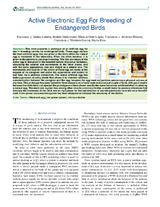Mostrar el registro sencillo del ítem
Active electronic egg for breeding of endangered birds
| dc.contributor.author | Quiles-Latorre, Francisco Javier | |
| dc.contributor.author | Gersnoviez, Andrés | |
| dc.contributor.author | Ortiz-López, Manuel | |
| dc.contributor.author | Jiménez-Álvarez, Francisco J. | |
| dc.contributor.author | Montoro-García, Francisco J. | |
| dc.contributor.author | Brox-Jiménez, María | |
| dc.date.accessioned | 2024-02-07T09:46:18Z | |
| dc.date.available | 2024-02-07T09:46:18Z | |
| dc.date.issued | 2010 | |
| dc.identifier.issn | 1558-1748 | |
| dc.identifier.uri | http://hdl.handle.net/10396/27220 | |
| dc.description.abstract | This work presents a prototype of an artificial egg for use in breeding centres for endangered birds. These eggs replace the inert artificial eggs that are given to the birds while the natural egg is incubated in the laboratory. When the chick hatches, it is given to the parents to continue breeding. This first prototype of the active egg is designed for the bearded vulture (Gypaetus barbatus), simulating the sounds and movements of the chick inside, and with the same appearance, size and weight as a natural one. The movements and sounds of the active artificial egg are made at the request of its caregiver and under his supervision and control in real time via a wireless connection. The active artificial egg has battery-powered circuitry inside that allows it to maintain wireless communication between the caregiver and the egg, because the egg must not perform autonomous physical actions at any time. This prototype has been tested for three seasons on a foster male and a natural couple of birds with good results because the birds have not rejected the prototype and have shown exactly the same behaviour exhibited when incubating a natural egg. The electronic system has among other circuits a microcontroller, a small motor to produce vibrations that simulate the movement of the chick and an mp3 player for the reproduction of sounds previously recorded on a microSD card. A low power consumption system has been designed to increase the autonomy of the device. | es_ES |
| dc.format.mimetype | application/pdf | es_ES |
| dc.language.iso | eng | es_ES |
| dc.publisher | IEEE | es_ES |
| dc.rights | https://creativecommons.org/licenses/by-nc-nd/4.0/ | es_ES |
| dc.source | IEEE Sensors Journal, Vol: 21, Issue: 22, (2021) | es_ES |
| dc.subject | Artificial egg | es_ES |
| dc.subject | Breeding centres | es_ES |
| dc.subject | Chick | es_ES |
| dc.subject | Battery-powered circuitry | es_ES |
| dc.subject | MicroSD card | es_ES |
| dc.subject | Vibrations | es_ES |
| dc.subject | Incubating | es_ES |
| dc.title | Active electronic egg for breeding of endangered birds | es_ES |
| dc.type | info:eu-repo/semantics/article | es_ES |
| dc.relation.publisherversion | http://dx.doi.org/10.1109/JSEN.2021.3114639 | es_ES |
| dc.rights.accessRights | info:eu-repo/semantics/openAccess | es_ES |

